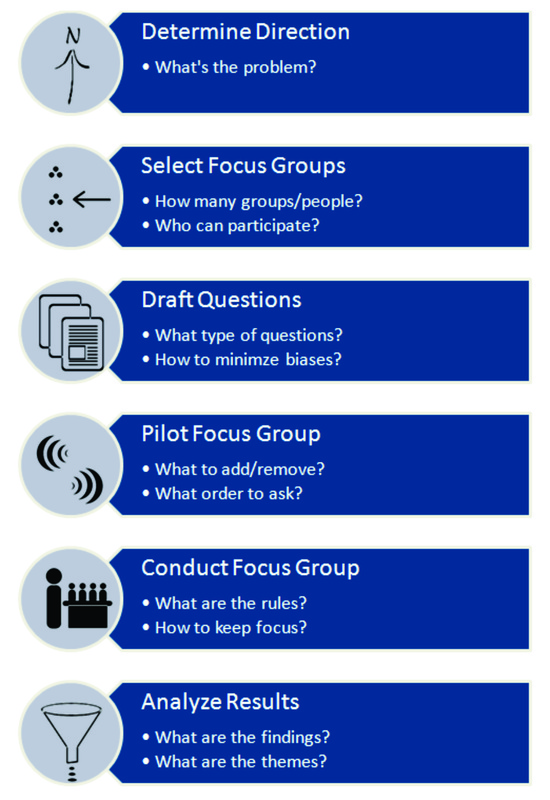
In this section there are the following resources:
- Focus Group Overview
- Focus Group Job Aid
focus group oVERVIEW
WHAT
Focus groups are a form of qualitative research in which a group of people are asked for their opinions on a particular subject in order to receive feedback on how to improve or modify it.
WHY
Focus groups are used to discover how different people think and feel about a topic and why they hold certain opinions.
HOW
Focus groups can take many different forms, however the table below from the Iowa State University Extension gives a general outline[i]
Format: Group session
Size: 8-12 per session; invite twice as many
Length: 1.5 to 2 hours
Number of sessions: Varies; should be more than 1
Participants:
1. Selected; by invitation only
2. Similar characteristics
Forms of data:
1. Conversation, including tone of voice
2. Silences (words and issues)
3. Body language
Collection of Data:
1. Audiotape
2. Transcribe
Moderator:
1. Flexible yet focused
2. Uses interview guide; modify based on early sessions
Formats for reporting:
1. Selected quotations
2. Analysis of repeated themes
ADVANTAGES
Two advantages for using focus groups are that they conserve resources and can provide specific information. Focus groups are cheaper and take less time to conduct than individual interviews. Additionally, they can provide detailed information about personal and group feelings, perceptions and opinions.
DISADVANTAGES
Two main external disadvantages of using focus groups are the observer dependency and the setting. Both the observer and the environment surrounding the focus group can have a profound effect on the results. The observer can influence the group through his/her biases unless the focus group is repeated. Additionally, the setting if not presented in an open and inviting environment may skew responses from group members.
USE IN THE REAL WORLD
Employers can use focus groups to gather feedback from employees. According to HR Specialist magazine, employee focus groups are a good way to uncover issues affecting productivity and retention.[ii]
RESOURCES
[i] Grudens-Schuck, N. , Lundy,B. A., and Larson, K., (2004). Focus Group Fundamentals. Iowa State University Extension. Retrieved from:http://www.extension.iastate.edu/Publications/PM1969B.pdf
[ii] Want real employee feedback? Use a focus group. (2011). HR Specialist: Compensation & Benefits, 6(8), 6.
Focus groups are a form of qualitative research in which a group of people are asked for their opinions on a particular subject in order to receive feedback on how to improve or modify it.
WHY
Focus groups are used to discover how different people think and feel about a topic and why they hold certain opinions.
HOW
Focus groups can take many different forms, however the table below from the Iowa State University Extension gives a general outline[i]
Format: Group session
Size: 8-12 per session; invite twice as many
Length: 1.5 to 2 hours
Number of sessions: Varies; should be more than 1
Participants:
1. Selected; by invitation only
2. Similar characteristics
Forms of data:
1. Conversation, including tone of voice
2. Silences (words and issues)
3. Body language
Collection of Data:
1. Audiotape
2. Transcribe
Moderator:
1. Flexible yet focused
2. Uses interview guide; modify based on early sessions
Formats for reporting:
1. Selected quotations
2. Analysis of repeated themes
ADVANTAGES
Two advantages for using focus groups are that they conserve resources and can provide specific information. Focus groups are cheaper and take less time to conduct than individual interviews. Additionally, they can provide detailed information about personal and group feelings, perceptions and opinions.
DISADVANTAGES
Two main external disadvantages of using focus groups are the observer dependency and the setting. Both the observer and the environment surrounding the focus group can have a profound effect on the results. The observer can influence the group through his/her biases unless the focus group is repeated. Additionally, the setting if not presented in an open and inviting environment may skew responses from group members.
USE IN THE REAL WORLD
Employers can use focus groups to gather feedback from employees. According to HR Specialist magazine, employee focus groups are a good way to uncover issues affecting productivity and retention.[ii]
RESOURCES
[i] Grudens-Schuck, N. , Lundy,B. A., and Larson, K., (2004). Focus Group Fundamentals. Iowa State University Extension. Retrieved from:http://www.extension.iastate.edu/Publications/PM1969B.pdf
[ii] Want real employee feedback? Use a focus group. (2011). HR Specialist: Compensation & Benefits, 6(8), 6.
FOCUS GROUP JOB AID
The job aid below is intended to provide first-time practitioners guidance on how to implement a focus group.

